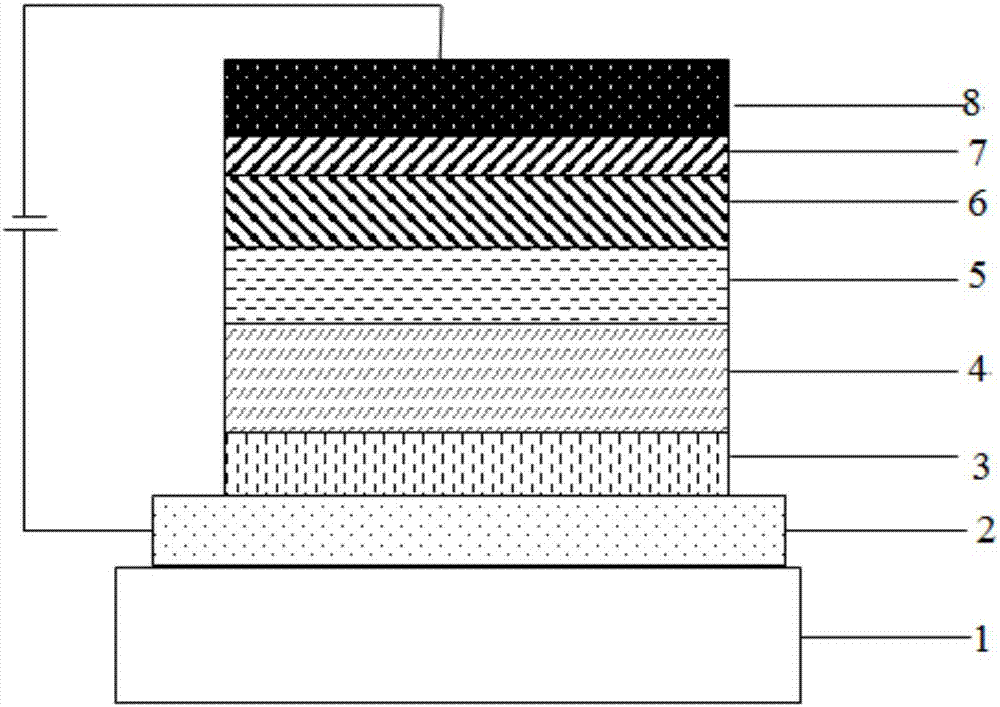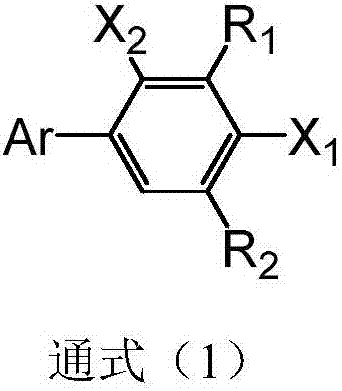Compound taking cyanobenzene as core, and application of compound in organic light-emitting devices (OLEDs)
A compound, cyanobenzene technology, applied in the application field of organic light-emitting diodes, can solve the problems of low S1 state radiation transition rate, efficiency roll-off, difficult exciton utilization rate and high fluorescence radiation efficiency, etc., to achieve good industrialization Prospects, good film formation, power efficiency and effect of improving external quantum efficiency
- Summary
- Abstract
- Description
- Claims
- Application Information
AI Technical Summary
Problems solved by technology
Method used
Image
Examples
Embodiment 1
[0076] Embodiment 1: the synthesis of compound 6:
[0077]
[0078] Dissolve 0.01mol raw material E1-1 and 0.012mol intermediate M1-1 in 150mL anhydrous toluene, add 0.0005mol Pd after deoxygenation 2 (dba) 3 and 0.015mol tri-tert-butylphosphine, and reacted at 110°C for 24 hours under an inert atmosphere. During the reaction, the reaction process was monitored by TLC constantly. Silica gel column, obtain intermediate target product, HPLC purity 99.9%, yield 76.7%; Elemental analysis structure (molecular formula C 37 h 22 N 2 O): theoretical value C, 87.04; H, 4.34; N, 5.49; test value: C, 87.02; H, 4.33; N, 5.50; The value is 509.98.
Embodiment 2
[0079] Embodiment 2: the synthesis of compound 16:
[0080]
[0081] Dissolve 0.01mol raw material E1-2 and 0.012mol intermediate M1-2 in 150mL anhydrous toluene, add 0.0005mol Pd after deoxygenation 2 (dba) 3 and 0.015mol tri-tert-butylphosphine, and reacted at 110°C for 24 hours under an inert atmosphere. During the reaction, the reaction process was monitored by TLC constantly. Silica gel column, obtain intermediate target product, HPLC purity 99.9%, yield 72.3%; Elemental analysis structure (molecular formula C 37 h 22 N 2 S): theoretical value C,84.38; H,4.21; N,5.32; S,6.09; test value: C,84.38; H,4.21; N,5.33; S,6.08; ): The theoretical value is 526.15, and the measured value is 526.01.
Embodiment 3
[0082] Embodiment 3: the synthesis of compound 26:
[0083]
[0084] Dissolve 0.01mol raw material E1-1 and 0.012mol intermediate M1-3 in 150mL anhydrous toluene, add 0.0005mol Pd after deoxygenation 2 (dba) 3 and 0.015mol tri-tert-butylphosphine, and reacted at 110°C for 24 hours under an inert atmosphere. During the reaction, the reaction process was monitored by TLC constantly. Silica gel column, obtain intermediate target product, HPLC purity 99.9%, yield 81.2%; Elemental analysis structure (molecular formula C 40 h 28 N 2 ): theoretical value C, 89.52; H, 5.26; N, 5.22; test value: C, 89.50; H, 5.26; N, 5.21; for 536.60.
PUM
| Property | Measurement | Unit |
|---|---|---|
| thickness | aaaaa | aaaaa |
| thickness | aaaaa | aaaaa |
| thickness | aaaaa | aaaaa |
Abstract
Description
Claims
Application Information
 Login to View More
Login to View More - R&D
- Intellectual Property
- Life Sciences
- Materials
- Tech Scout
- Unparalleled Data Quality
- Higher Quality Content
- 60% Fewer Hallucinations
Browse by: Latest US Patents, China's latest patents, Technical Efficacy Thesaurus, Application Domain, Technology Topic, Popular Technical Reports.
© 2025 PatSnap. All rights reserved.Legal|Privacy policy|Modern Slavery Act Transparency Statement|Sitemap|About US| Contact US: help@patsnap.com



